#I also want to make mention of Babel being another B
Explore tagged Tumblr posts
Note
My question. A died, B did the whole murder thing. What happened to c, d, e, f, g, h, I, j, and k.

The prodigies of Wammy’s house are mostlyobscured, with the works making mention of them scattered, often not designed to function with the main timeline.

Yet, they have referred to one another in passing throughout.
– For example, “L: Change the World” very specifically references the case in “Death Note Another Note”. And, “L prologue to Death Note: Spiraling Trap” nods at “L: Change the World”.
Actually, all but 4 (C,O,S, & U) of the 26 letters of the alphabet have appeared in some form.

We know that all fall somewhere within the span of 4 generations, the first generation consisting of at least 5 individuals - A & B and the final children of the first generation, X - Z. J appears to have been the only officially succeeded by another child. And, K is the only letter that clearly demonstrating when letters can be passed on. But, it is not clear whether the letters spanning the entire alphabet must be assigned before a generation is completed. What is clear is that a generation consists of at most all 26 letters.

Letter’s that are (assumed or) confirmed to be deceased are A, B, F, R, T, V, X, Y, and Z. (J and K are alive, though J could be assumed dead). With all these deceased child-agents to L, it leaves one to wonder why the program continues generation after generation. But as we go over the sources involving the letters the answer becomes evident that the existence of Wammy’s children, necessitizes the existence of Wammy’s children…
Reiterating – the stories were not created to function perfectly together, but we can put together a timeline in which some version of these successors could exist together.

F may link the Kira case timeline with L : Prologue to DN (Spiraling Trap), L: Change the World, and DNAN, which we’ll explore.


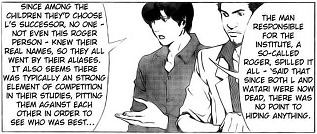
In the manga, Aizawa and Matsuda describe that among the children, few were selected to be L’s successors and no one knew their true names – It can be assumed that children arriving to Wammy’s House come without a true identity, then are selected to be successors. Most Wammy alumni fit into one of three categories: detectives, scientists, or artists, though some have branched beyond these.


Another description of these children is made in the novelization of “L: Change the World” [013]:
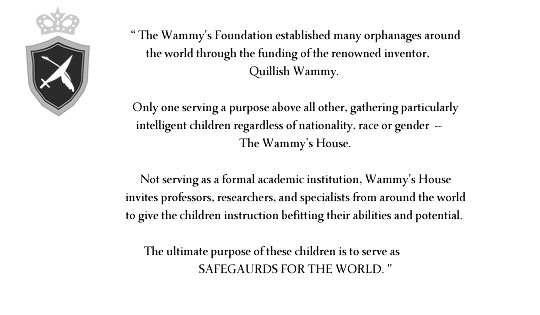


We will start with what we know of A - Z then draw a timeline.

We begin with the first of the first generation - though, A commits suicide and B commits murder, there is more here to examine…

A is only mentioned once in Death Note another Note,
“…The first child, A, was unable to handle the pressure of living up to L and took their own life…” [105]

It is assumed that A’s alias is “Alternative” due to its use with backup in the English edition:
“ … L’s successors, as L’s alternatives… a copy… a backup.“ [104]
However, the Japanese original does not have an A-rendering word – instead using a word that is actually 代替品 (dai-tai-hin) but the meaning is still equivalent.

The first child, A’s gender, background, age, cause of death, nor burial is ever expanded upon. However, A is the first attempt at creating a backup for L - presumably orphaned, stripped of all identity and purpose beyond becoming someone else - This gives the character a special place in history of Wammy’s House.
It is unclear how or where A died, but this character may also be the first and only child to have died on the institution’s grounds …

B is not the only Wammy’s alumni to have ended up in prison (one of at least 3) nor the only one to have attempted to attack L in some way.

B as a successor is made mention of several times,
” He had these eyes… which is why a child as strange as he was taken in by our home sweet home - Wammy’s House.“[094-095]
”…the second child in Wammy’s House…“ [095]
”…the second child, Beyond Birthday, was brilliant and deviant…“[105]
” B stood for backup. “ [105]

He was the second child, the backup. Wammy’s does not know his real name, making the search for him in May (year unknown) difficult.
“…B’s disappearance in May…” [117]
“… Wammy’s House only knew him as B - they did not know his real name…” [117]
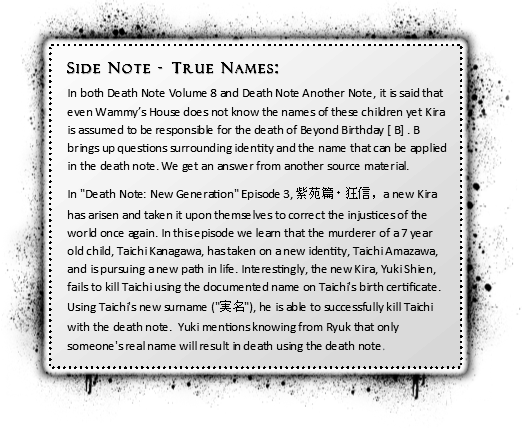
It may seem flawed that Kira could have gotten Beyond Birthday’s name unless he had given it upon his arrest, but this is a misunderstanding, the novel states Naomi herself could have known his name.
“… and if she had dug deeper would be able to find out that his real name was Beyond Birthday… He wanted them to find out he was Beyond Birthday…” [162]
It is never mentioned why B runs away though there is mention that he does so knowing L will be contacted by the house. [159] This may suggest that others have left before, but it is unclear.
His background is mentioned briefly but no nationality is suggested.
“… Knew the day when his father would be attacked by a thug and die, knew the day when his mother would die in a train crash…”[094]
It is notable that he speaks Japanese like a native, claims to have had every book of Akazukin Chacha as it was serialized (in the 1990s) – the books in Believe Bridesmaid’s home.. may not belong to the victim, B may have brought them with him.
”… He speaks Japanese like a native …“ [098]
”… I read every issue as it was serialized…“ [058]
”… there was no telling if Akazukin Chacha actually belonged to Believe Bridesmaid…“ [062]

Several mentions are made throughout DN:AN that could describe B’s appearance but none are certain to not be part of his Rue persona,
Young man [038-039]
Obviously not a child [044-045]
Wearing Jeans [078]
Applying makeup [106][162]
Scrawny and hunched over [143]
The same can be said for his mannerisms,
Jam eating [048-050]
Crawling on floor [051][057][072][074-076][110]
Wiping hands (knows floor is dirty) [078]
Biting thumb nail [052]
Using percentages [054][086][116][136-137]
Mathematical ability [054][112]
Reads Speedily [062]
Photographic Memory [063]
Cracking neck [074][106]
Laughter [095][106]
“L sitting” [079][085-086]
Drinking ‘sweet dirt’ [080]
Drinking unsweetened coffee [122]
However B’s end, like A’s, was to be suicide had he succeeded…

More on the original text for 1st Generation: [X]

One of the most generous collectives of letters is L’s contact list for Wammy’s shown in “L: Change the World”.
L brings up the contact list to inform the others that Watari has passed away. (Below)
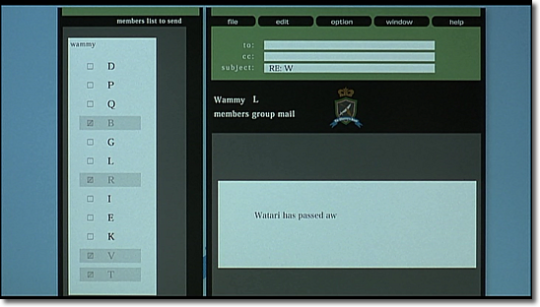

In the film “ L: Change the World”, L’s a contact list for Wammy’s House consists of 12 members of which four are in grey, the box unable to be checked. These four are B, R, V, and T. There is no particular order to the list, not alphabetical nor in order of induction which would place L at the top or bottom. The four in grey may be disabled due to death of the person holding that letter, based on the assumption that B is the same of “Death Note Another Note” (the film coming out in 2008, while Another Note novel came out in 2006) and that K is not at her computer (idle or unavailable).
Not everyone on the contact list receives this message – including B, R, V, and T which appear to be grayed out. (L only clicks 8 )
However, two characters, F and H , also appear in the film but are not in the list. F dies – However, F has been more in contact with Watari directly than with L. H too communicates directly with Watari about F’s demise – H may mean “Headquaters” or their message may originate from there.
Letters from other materials, notably J, do not appear in the contact list.

C has yet to be assigned.

D does appear in Wammy’s group email.


E also appears in Wammy’s group email.



F is held by a character in two different materials and could be said to be the most reckless of the Wammy’s letters…

In “L: Change the World”, F (F1225) appears in the movie and credits but does not appear in the novelization - ‘F’ is the character’s name in the credits.
Note on Novel: F’s absence in the novel is only one of several differences.
There are entire scenes in the book that do not appear in the film. The most notable of these are those with FBI agent Sugita and Fairman (Naomi’s replacement), Hatsune—a terrorist and killer since the age of 15, as well as Near being an active member of Wammys already and not a boy rescued from Thailand by F.
Other characters play more active roles including Watari (as a sniper), L (posing in a bear suit and later going on the run from K, the FBI, and Blue Ship), Maki Nikaido (defending an elderly woman and taking a very active role in infecting K).

In the film, F appears in Thailand after a sudden, mysterious, and deadly outbreak. F seems to have taken no precaution to protect himself, secretly observing the investigation being conducted by seemingly foreign scientists.
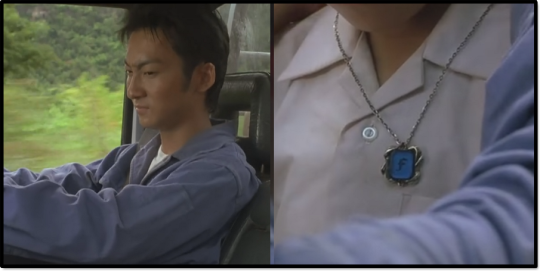

There is no direct explanation for F’s presence in the area of pathogen release but F was working undercover for Watari near the area at the time, similar to the situation within the game.
F’s risk-taking behavior aligns with the character in the game L: prologue to Death Note: Spiraling Trap [螺旋の罠 コミュニケーター]. In the game, Watari states that F specializes in the investigation of dangerous places – investigates the interior of all hotels in Ciela which could be rigged with bombs in that instance.

The movie may be the source of F’s mention for the game.

Following this information (after F’s death in the film), H communicates to Watari that the ’biomonitors’ had not been responding (either at the time or after this event). It is unclear what was being measured by the biomonitors, whether they are measuring something within the environment or F’s signs of life, but in trying to escape the area with Near in tow, F succumbs to the deadly pathogen he was exposed to. There is no indication that there is any attempt to retrieve his remains after the explosion that destroys his vehicle.
F may not be of the first generation but appears old enough to have been part of the first generation. Which means that F is a casualty of his peer, K’s, deadly plans…


G also appears in Wammy’s group email.



H is mentioned in “L: Change the World”, they may only symbolize Wammy’s [H] eadquarters or perhaps be a individual within Wammy’s itself.


Roger may be the person behind this letter as H works as the liaison between Watari and the rest of the letters. The message communicating F’s demise says they must select someone else for F’s investigation. It is notably unsentimental and to the point, much like a telegraph though the shortness is unnecessary…
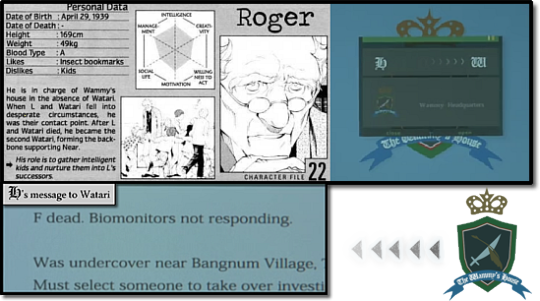
If H is Roger, this may explain Roger’s presence in Wammy’s House despite “How To Read: 13” mentioning that among things he dislikes are children.
It is also worth a short note that Roger, upon Watari’s death and the disappearances of Near and Mello, makes no attempt to hide the purpose of Wammy’s House from Aizawa and Matsuda. But, despite hating children, Roger was already present in Wammy’s House before L became a famous detective - in “File. 15″ - Chapter 0, Wammy’s House/Day One:

Though he has evidently not washed his hands of L or his successors – in what has been called chapter 109, the one-shot special (Weekly Shonen Jump, volume 11 ) featuring Near shows that 3 years after Light’s death, Roger is serving as Near’s Watari …
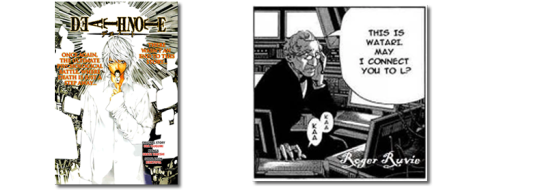
It is not entirely clear whether or not Roger continues the successor program beyond this point. Though, “L: Light Up The New World” does have the IVF Ryuzaki as a new successor, he is not a child.
Additionally, Near states in the main manga (Volume 9) that in order to ensure that Mello will not be killed by the death note, that those at Wammy’s that have known Mello have been dealt with [対処]. It is unclear what all having been dealt with would entail, beyond that they can be expected to stay silent on Mello’s appearance.

This along with Vol. 9, page 166 - Near states that if he and Mello die (if he is wrong about the 13 days rule), Kira would have won - Suggesting there are no further challengers lined up at this point.
It remains unclear whether Roger is H or continues the successorship program after he is clearly not at his post anymore 3 years post-Kira case - But, he does become Near’s Watari (which is Wammy’s code name meaning handler).


I is also in Wammy’s group email.

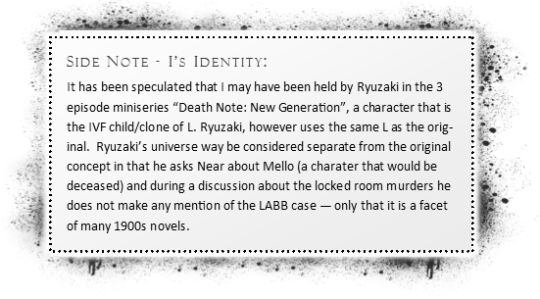
Ide did use an I as an alias during the Kira case (arc 2). However, this is the same font used by Light when he is behind the alias L and Near’s N in the manga, it is not Cloister Black nor Old English MT, it is a different variant of Old English Font.
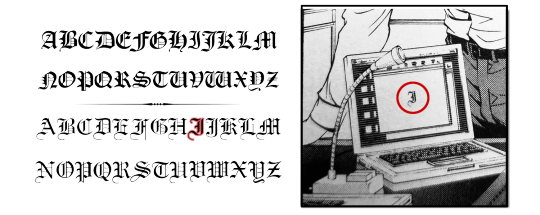


J is unique in that J is a letter that has been assigned to two individuals…
J of “L: The Prologue to Death Note: Spiraling Trap” [螺旋の罠 コミュニケーター]
J of “Death Note: New Generation”


In the prologue to Death Note, a kidnapped FBI agent wakes up in what appears to be a hotel room (this is following an investigation under L into a weapons trafficking organization CLN in which they were attacked).
It is not a hotel but a boat (Granada) that is full of explosives in some area around Central America, Criela [クリエラ] Republic - it is thought to be headed to the Atlantic Ocean, where it is intended to sink, but the autopilot has been tapered with and it is instead headed to the Altea [アルテア] port which is the controlling area of the Criela government…

This would look like an anti-government attack if it were to explode at port, and L would look as though he had some involvement with his agent aboard.
L makes contact with his agent at the time not knowing their location when, J intercepts the communication, he claims this is part of his revenge… on L.
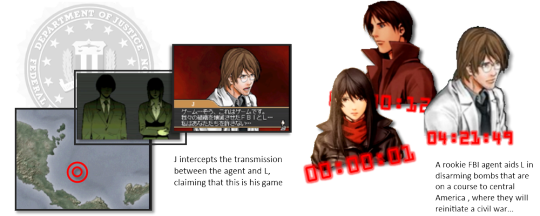

J claims to be a part of “クリエラの月”, a terrorist group that intends initiate the civil war in this country. However, this is not true and he has very little knowledge of the explosive’s mechanisms, though he is part of the main control program for the explosive’s detonation.

J is a war orphan, described as a man in his late 20s, having a gentle manner. He graduated from college as a programmer and joined Reboot Inc. (group that owns this boat) under his code name Jeffery Miller.
Summary Profile [X]
J lost his family due to CLN’s arranging bombs to be set off during a civil war in what was Yugoslavia.
After the loss, he was entered into the protection of war orphan support groups ( including the Alois Bateson’s Foundation). He was loyal to Alois for his kindness but was deceived – Alois is actually an executive of CLN (COMBAT LOGISTICS NETWORK), multinational military industry in the Middle East.

While the company J works for, Reboot Inc., owns the ship, CLN is a shipping company with a dock large enough to hide this ship and loads it with explosives. The ship is evidence of for L’s investigation and CLN figures as long as the ship detonates, they will have won either way – they will either prove they have a bomb even L cannot defuse and become the go-to weapons supplier or they will have initiated the war they want. J’s role in this is to pretend to be the mastermind to keep L occupied, monitor L’s movements, and manage the Housekeeper (a codename for one of the badguys and the person whom actually placed the bombs on the ship).
J, after learning he has been deceived, has a change of heart - L appeals to his feelings on war and he cooperates with the FBI agent to stop the ship. He is later arrested for his involvement and his true identity is revealed on TV – クリロ・ミラニッチ, Cliro Milanic…
J says to L that he does not regret what he has done because he had the opportunity to talk to L.

The second individual holding the letter [ J ] is J of “Death Note: New Generation” Episode 2. In it, Ryuzaki [L’s official successor] is the IVF child/clone of L that appears in
Ryuzaki appears close to Near and the second “J” – both Near and J do not show their faces through communication with Ryuzaki but do use what appears to be their natural, non-synthetic, voices.

J meets Ryuzaki in person (In Tokyo, Japan), showing up at J’s location semi-unexpectedly. Though he appears to have arrived to retrieve tools for his investigation, J invites him to sit down and enjoy the spread that she has presumably prepared and laid out in anticipation for his arrival, Ryuzaki comments that they are not children anymore – it may be a birthday, celebration for a case solved, or another significant day for them (this takes place before the locked room murders are confirmed to be the work of Kira).
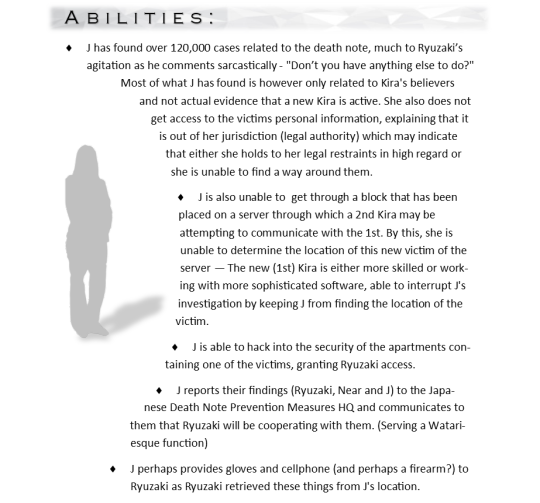
J has recovered the mask that L has used to protect his identity during his investigations and presents it to Ryuzaki as a gift.
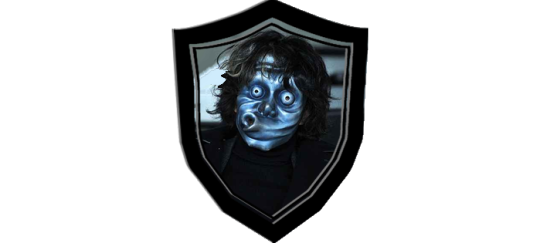
J ultimately wants to persuade him to become involved in the new investigation, Ryuzaki and Near have already made an agreement that whomever solved the locked room murder first would be in charge of the case thereafter - Ryuzaki appears to have been resisting becoming involved.
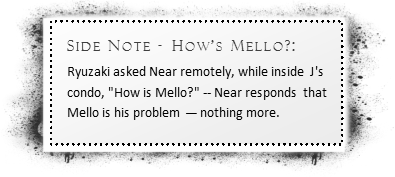
J wants to further assist with the investigation, serving as the new L’s Watari figure. However, Ryuzaki declines the assistance of J, stating Watari’s death was L’s greatest regret…


K is another of the few letters that makes an appearance in both the film and the novelization of L: Change the World.


[ K ] is the first of their letter, another of the few that make an appearance. In her childhood, K an agent of L, serving to mobilize the world’s agencies of law enforcement. She continued her service until a rescue mission to recover a child from the clutches of a terrorist organization destorys her faith in herself and the world.

The rescued child was that of the terrorist mastermind and upon being received by the rescue camp, they detonated an explosive attached to their body - it was a suicide bombing, a parent sacrificing their own child to kill others.

After witnessing what K describes as many casualties, she abandons her post at Wammy’s at 16 years old, saying she is ashamed of her failure. [176]

K leaves but not to go into hiding, she is out for revenge…
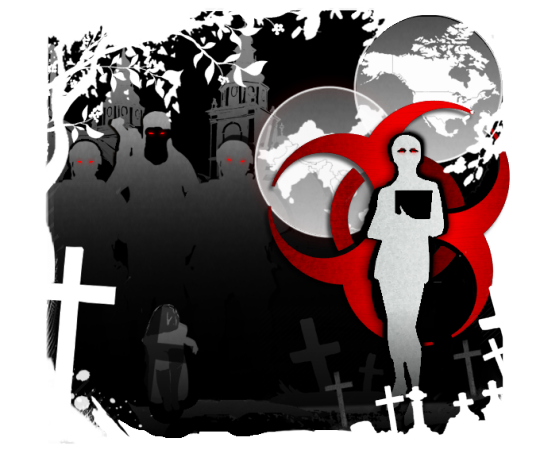
When she is around 30 (26 years after the deaths of her parents) she has situated herself in the organization Blue Ship—an environmental terrorist group intending to reduce the human population through utilization of a deadly virus, for which there is only one cure.

The organization is ruthlessness, knowing no loyalty or limitation as they regularly dispose of their own team members (119)…


One member (Dr. Kagami, writer of “Alert Status Red: The Human Species” ) is stabbed to death and feed to eels in front of his team members.

K is critical piece to their plan as she assimilates herself into the research laboratory of Dr. Nikaido (immunologist ), a personal friend of Watari, single parent, family friend of the Amane family, and former professor of Wammy’s house.
After working with Nikaido for several years, even tutoring his child, she betrays him. Even the chimpanzees that K works with appear to sense that she is dangerous – But, Dr. Nikaido’s death was accidental, upon being confronted by the masked members of Blue Ship asking him to surrender the virus, he provokes one into shooting him with the intention that if they cannot obtain the cure then they will not use the virus (for fear of being infected with no means of saving themselves)…

— Dr. Nikaido deletes the data on the cure through a hacking security systems created by Q, given to him through Wammy. But, K knows her way around it from the inside and ultimately, it is unable to stop the terrorist infiltrators. The body of Dr. Nikaido and the living animals inside are incinerated in the fire induced by Blue Ship…
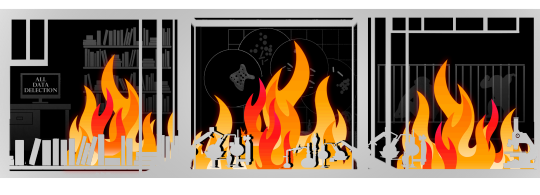
When it comes to Wammy’s alumni, it does not get much more diabolical than K. Backup (B) may take the cake for being infamously grisly but K, Dr. Kimiko Kujo, after absconding from her role with Wammy’s house, successfully obtains a deadly virus to unleash upon humanity – ultimately betraying Wammy’s, her coworkers, L, her terrorist team, and even herself – with the intent to indiscriminately wipe out the species entirely in a bid for revenge.
She is perhaps the most apocalyptic of the first generation letters. The events that put K on this path are as brutal as the events that follow obtaining the virus :

— Her parents were the victims of an explosive fire in a lab on the East Serras Island, their place of work as researchers (though not involved in the research into infectious weapons). The destruction of the laboratory was the decision of the US government after the discovery that some of the researchers, belonging to a terrorist organization, were on the brink of constructing a deadly biological weapon they intended to use in response to the presidential election. A key individual in the attack is Matoba, a leader in Blue Ship– he carries a facial scar from the explosion and becomes another K infects.
Aside from her terrorist team, Dr. Nikaido, L, and Wammy’s— F is another causality of her plot, investigating the sudden outbreak that is the result of Blue Ship testing out the virus to demonstrate it’s deadly applications to potential buyers (for 4billion). With F appearing to be around the same age as K, this may in fact mean she is the catalyst of the demise of one of her own peers.

There appears to be no clear limit with how far K will take her plan…
She even impersonates L, abusing her hacking prowess to get into the Kira investigation system, to contact the US president (David Hope), making a request of 10 billion USD or L would end the president’s life after compelling them to launch nuclear missiles at London, Moscow, and Beijing. She nearly succeeds as VP Godwin actually suggests using a small nuclear weapon to kill L. In spite, of Secretary of State, Beal, asserting that it would initiate a war with Japan.
This is in attempt to provoke the US government into hunting down and eliminating L. At the time, this is a tangible threat, not only is L in possession of 2 death notes but the US has sent an FBI agent— Hideaki Suruga (Hideaki Sugita), FBI agent taking up Naomi’s duties, close friend of both Raye and Naomi, even would have hosted the wedding reception — to retrieve the death notes.
Agent Suruga, was initially working with Agent Robert Fairman –turning out to be an FBI infiltrator attempting to stage a vehicular explosion that would kill Surgua and seem as though the files too were destroyed.
These files contained the details of the 1980’s Attache Case—the explosion that took the lives of K’s parents.
Though K presents herself initially to Suruga as part of the Tokyo Police Department, Public Security Bureau, 3rd Foreign Affiars division – Counterterrorism division, K reminds the FBI agent of Naomi herself. Suruga remarks internally upon discovering K attempting to hack into L’s security – “Damn, women are scary.”
She is perhaps from the first generation, appearing to be the appropriate age, around the same as F, and is referred to as the first of her letter. This may in fact mean she is the catalyst of the demise of one of her own peers (F)..

This event seems to have taken place after B’s death or imprisonment, going on the suggestion that B is dead from L’s contact list, and perhaps after the disappearances or deaths of X, Y, and Z as well..
It can also be inferred that this takes place after J’s arrest given that F is still alive and active during J’s crime.
Additionally, Sugita’s partner Fairman, is Naomi’s replacement as of 1 day after her quitting, and Naomi doesn’t quit the FBI until 2003. [009]
K brings some light to how one’s letter is passed on to another; K is arrested and given a life sentence though L informs her that Watari has said, should she ever be able to return, she would be forgiven and could resume her role as K.
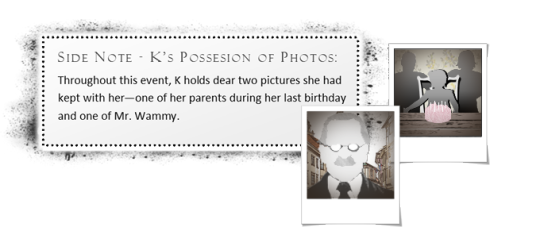
What’s a little mass-homocide when you’re a 1st gen successor? Actually, .. L suggests that her lack of faith in humanity comes from her being a student of Wammy’s. – To which K agrees…

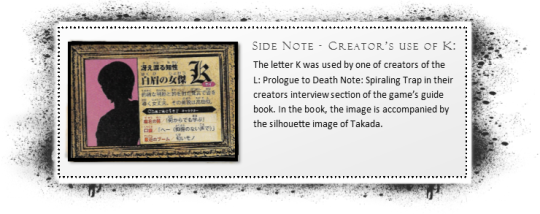


O has yet to be assigned.

P also appears in Wammy’s group email.



Q appears in Wammy’s group email and is the person whom build the program for K’s laboratory security.
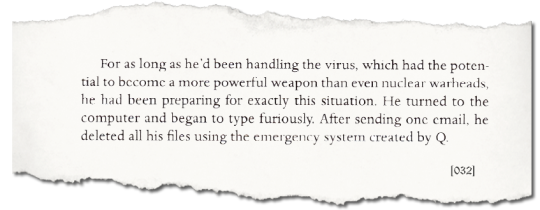

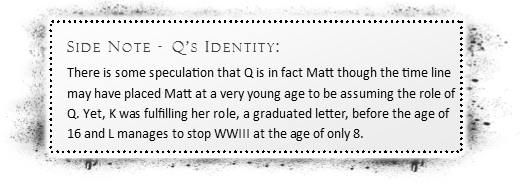


[R] is in the group email but grayed out, suggesting they are deceased.


[S] has yet to be assigned.


[T] is in the group email but grayed out, suggesting they are deceased.

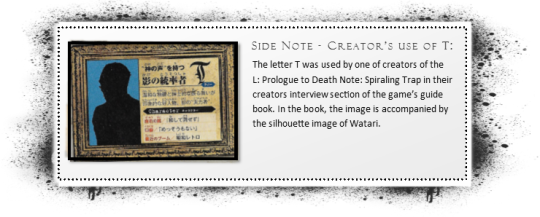

[U] has yet to be assigned.

[V] is in the group email but grayed out, suggesting they are deceased.



[X], [Y], and [Z] are the last of the first generation, mentioned as being involved in the detective wars that earned L the code names of Eraldo Coil and Danuve.


“… The story of the detective war… solving that infamous bioterror case, with guest appearances by the first X through the first Z from Wammy’s house…” – [170]

In the original Japanese edition, they are specifically referred to as 初代 X - Z which means the first generation or the original ones, the first generation.

This may be interpenetrated as suggesting there were others later on that held these letters but X,Y, and Z do not appear in L’s Wammy contact list in “L: Change the World”.
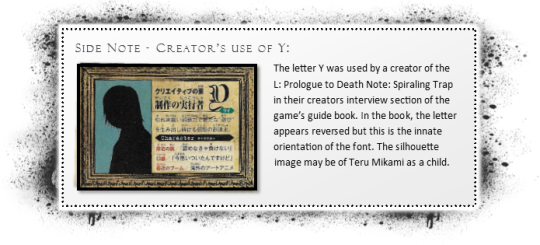

In less than 17 years – between the time of L’s discovery and death –several successors veered off the intended path. In fact, being a successor between just the 1st and 3rd generations, your chances of committing suicide are at least 257x higher than that of the general population of the UK, your chances of imprisonment are 277x higher, your chances of committing murder are 770x higher …
And, that is a conservative estimate – given we only know the fates of a few.
The children are brought out of the obscurity and given an opportunity for a greater purpose for which the world cannot discount. In their world, L himself is essential in preventing the third world war. Even ignoring the death note, their world is a increasingly dangerous, full of violence, war, and weaponry that could devastate the planet – In some ways much like our own. These are intelligent and exceptional enough to lead their world into the future, their education hones and harness their innate abilities to serve the greater good. But, it is at the price of their ignorance and often their faith in humanity, exhausting their compassion and, in some instances, with a nihilistic perspective.
Childhood’s veil of security is often lost when one loses their parents, the world never feels quite as safe when you live through something that destabilizes your entire life. Compounded with the realities that others are not exposed to, the worst of humanity, the parts that make you wonder how a person can live with themselves, the call to action is urgent and dire.
For some, failing their responsibilities to the world is too great a shame to bare. Yet, others are so full of their own malice, life is a small price to pay to prove a point…
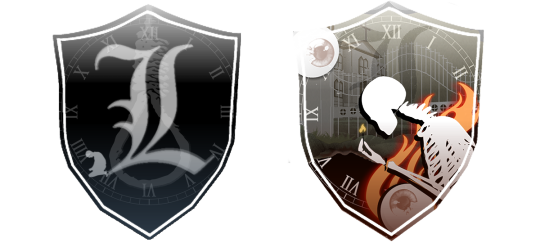
Then there are those that will live to leave, only to bring war to your nations…
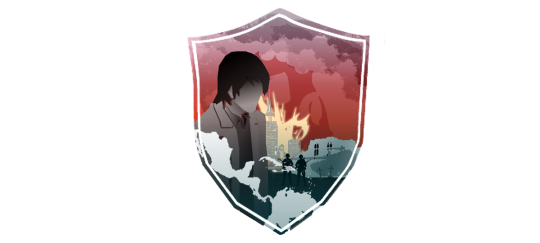
But worst of all these children are those cunning and determined and devastated enough that they will bring the apocalypse …

Can you image what 2, or 3, or more could do?
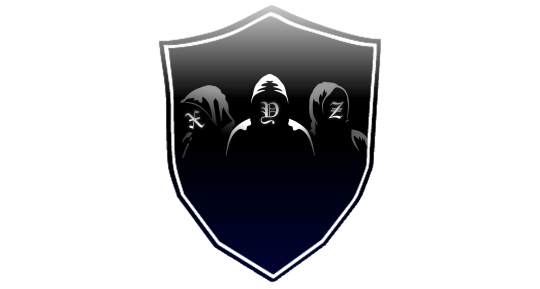
This is why the existence of Wammy’s children necessitizes the existence of Wammy’s children …


Reiterating, – these works were not created to function perfectly together on a timeline. For example, “Death Note Another Note” and “L: The Prologue to Death Note: Spiraling Trap” both erroneously presented Naomi Misora as already engaged to Ray though Ray does not propose to Naomi until 2003.
In order to create a functional timeline, we must assume at least 3 things:
The F of Spiraling Trap (J’s case) is the same involved in “L: Change the World” (K’s case)
The contact list in “L: Change the World” has greyed out contacts that were alive at the creation of the contact list but are deceased based on L clicking 6 times (D, E, G, I, P, and K).
We can dismiss the mention in Spiraling Trap and DNAN [124] that Naomi is engaged and has an engagement ring.

Now we can begin constructing a rough timeline, starting with the first generation:
A must have died before the creation of the contact list.
X, Y, and Z also seem to have died before the creation of the contact list.
B was on contact list before death and before DNAN, placing the creation of the contact list before the events of DNAN.

Next is Spiraling Trap, Prologue to DN, J’s Case:
J is not on the contact list which places the events that led to J’s arrest to be before the creation of the contact list (and DNAN).
F’s involvement places it before K’s case
Additionally, Naomi’s involvement places J’s case before her retirement in 2003 and her leave of absence in 2002.

Finally for K’s case:
The deaths (or disappearances) or R, T, and V must have occurred after the creation of the emailing list because it would not make sense for dead successors to be included, unless they were added while still alive.
Additionally, their deaths must have happened before K’s case because they are dead before L begins to investigate.
H is possibly Roger and at the time of K’s case, H is alive.
D, E, G, I, and P appear to be alive at the time of K’s case.
Q is also alive based on their letter’s inclusion in the contact list and their involvement in the security system of the lab in which K begins work.
F dies during K’s case but is active during J’s which gives more evidence to J’s case taking place before K’s.
Though it is a side note, L: Change the world mentions B’s case (089) which clearly places the events in the same universe and taking place after the events of DNAN.
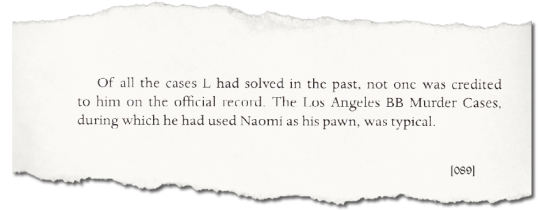
Additionally, the book gives an idea of what month these events are taking place in when mentioning a time for the next victim of the death note (125):
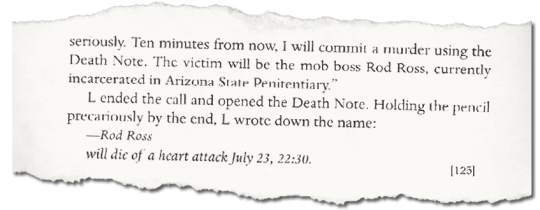

If L established a means of contact before the LABB case, it makes sense why J reacts the way he does at the end of his story:
At the end of J’s case, J appears to be so honored that L has communicated with him that J concludes that the crime has still been worth it in the end.
It also may make sense why K seems so surprised that L knows that she is from Wammy’s house, not at all concerned about being recognized when meeting face to face.
In conclusion, K happens sometime around the Kira era but before the conclusion of it, B’s case occurs before that and J’s before that.

#beyond birthday#the first child#death note a#I will eventually screen shot where Watari talks about F and add some notes in here about B's name#I also want to make mention of Babel being another B#wammys house#Wammy's Kids#wammysfirstchild#wammy's A#The Detective Wars#brilliantanddeviant#xyz#wammys first generation#meta
206 notes
·
View notes
Note
Why is hanseok considered the greater evil, and vincenzo the lesser evil?? I genuinely dont understand, can you explain it to me please??
hiii thank you so much for sending me an ask!! i'm not going to lie, i saw this ask a long while ago when you originally sent it but it took me a long while to answer it because i really had to think about it and also it's kind of a hard question for me to answer. but, i will attempt my best to kinda give my thoughts on why we consider vincenzo as the "lesser evil."
first, i need to say that both vincenzo nor han seok are good people and i am not saying that either of them are good people. i am simply comparing their evil levels and explaining why we as viewers often find vincenzo to be the lesser evil than han seok.
second, we need to define what evil means in this context (which is kinda hard because it depends on each person's perception but aaa) if we're considering someone evil for purely their actions, excluding motivations, then both vincenzo and han seok are the same level of evil. han seok brutally murders, and psychologically and physically abuses people. vincenzo's actions (aka setting people on fire, abusing and murdering people, torturing people, etc.) also makes him evil.
BUT if you define evil through motivation, then vincenzo and han seok are still evil but not on the same level of evil. yes, both characters commit bad actions but their motivations are different. vincenzo kills only when given a reason to. for example, we know that a robber killed his foster parents so when he joined the mafia he both psychologically and physically tortured him for almost a year (now whether the method of killing is a justifiable or an equal punishment for the crime is an entirely different question and i just won't be able to answer that because it's just so hard and complex of a question.) he sets the warehouse on fire to get revenge on behalf of the victims of the drug produced in said factory. he kills the two people who killed cha young's father and he kills the people who set up the family of the dead researchers to look like a suicide. he only kills or tortures people who have done a wrong against him or the people he cares about.
on the other hand, han seok kills and tortures for his own amusement and gain. he kills the prosecutor with the hockey stick because he didn't get his way and they annoyed him. he allows and gives the resources to choi myung hee to kill or maim anyone that gets in the way of his plans. han seok murdered his classmates for no reason other than he didn't get what he wanted. and most of all, he tortured and abused han seo just for his amusement. han seo was his punching bag, where he would belittle and abuse him in order for han seok to get his anger out. he does bad actions without a given or justifiable reason. he would play with han seo and keep him on the edge at all times, because he got a power rush from it. so when you compare vincenzo and han seok's motivations for their actions, i don't think you can say that vincenzo is the same level of evil as han seok.
we also don't see vincenzo attacking someone beloved to the person who has done wrong in order to get revenge. for example, in order to hurt vincenzo, han seok kills vin's mother, who has not done anything wrong this situation. but with vincenzo, we never see that happening. even though we see vincenzo hanging out with prosecutor jung's family after he betrays them, there's not a moment that he actively threatens or attacks prosecutor jung's family. he doesn't threaten prosecutor jung or tell him he will kill his family because in his mind, it's not justifiable to take the life on another person who hasn't done wrongdoing in order to hurt the person who has. for han seok this is not true, he has killed or attacked innocent people to make his enemy hurt.
another reason we are bound to consider vincenzo 'a lesser evil' is because of remorse. despite vincenzo's motivations or actions, he displays remorse and regret for the killing he has done. han seok, on the other hand, does not. Vincenzo is haunted by the killings he has done, by the blood he has spilled and we don't ever see that ending even when he gains a family and gains love. even if he can justify his actions, he is still regretful of what he had to do. han seok does not show the same remorse as him, only feeling bad when it is his life that's under threat in the very last scene. not to mention that he brags about killing, he gets power and happiness from his killings both when he killed his classmates as well as when he killed the prosecutor. han seok takes pleasure in his actions, as he is shown dancing and being gleeful as he kills vincenzo's mother and many others. he has no regret or shame in what he has done.
in so many law and crime shows we see a "morally" good hero who "spares" the villain in the end because it is the "right thing to do" despite a) killing all their side minions that helped the villain and b) all of the villains evil actions and harm they have caused the victims. we, as viewers, often aren't satisfied at the end because we're not seeing the punishment match up to the crime. this show's main thesis is showing that han seok is so evil that no law or justice system can properly punish him for the pain and abuse he has inflicted on his victims AND because this system that is supposed to punish him is just as cruel and corrupt as he is. it's highlighting the injustice to the victims of babel as a corporation, victims of the justice and law system and victims of han seok himself. vincenzo is showing that he is the best punishment for han seok because vincenzo is a mirror to him and han seok in the end is getting a taste of his own medicine.
all of this is why that last monologue of the show is important. we, as viewers, are watching a show that frames vincenzo as the main protagonist. his actions and him are framed in a way to make us root for him, with the music and the cinematography. but we're also given small reminders of who he actually is throughout the show: through the nightmares he faces, through mr. tak telling him not to change into a lighter person, through the scene where he faces han seok in jail. and finally, that ending monologue is showing that no, he is still a bad person. he is still an evil person who is committing bad actions and us rooting for him to punish the villains in this show does not change the badness of his actions. really, that last line in vincenzo is making us question whether his actions are justifiable and can we actually root for him.
feel free to disagree with me or start a conversation below because i feel like this is a really interesting question but the answer to this changes based on each person's perception of morality and what constitutes a good person and a bad person. i feel like this is such a deep question and there's so many ways and angles that you can look at this from so i don't think i've done a great job in explaining everything but this was just what i came up with for today. there's also every chance that my line of reasoning or logic is flawed so i'm open to any criticisms to this so i can acknowledge and correct it!
(also if you want a good kdrama that asks these same questions and has that same energy as vincenzo then please watch taxi driver! it’s a great show and it really makes you think about the earlier questions of “does the punishment given out by vigilante justice match the crime committed by these people? to what extent is vigilante justice justifiable? where does the law draw the line between giving the victims of brutal crime justice vs protecting the criminal from cruel and unusual punishments?”)
#mine#vincenzo#chayenzo#vincenzo cassano#hong cha young#song joong ki#tvn vincenzo#jeon yeo been#vincenzo x cha young#meta#analysis
130 notes
·
View notes
Note
Hello! In the light of Storyteller Saturday writeblr event, I'm sending some questions around & since I love your work, I wanted to ask you something too even if you don't participate. :P Sooo, you haven't told us much about Topiary Black. How is it going, first of all, and what are some of your plans for it at the moment. How is Coldwater Sound's 2nd draft going, you had mentioned you were thinking of two different versions of it. No pressure, this is only if you wish to talk about them. ^^
I’m somewhat restrained when it comes to revealing details about my WIPs while I’m drafting, and what I do share is only after deliberate consideration. That said, I’d love to answer your questions, but I want to touch on my reservations as well because I don’t think I’ve ever talked about it here.
Oversharing cripples my process and my work because:
A) My creative well empties
If I receive validation or catharsis from revealing information or excerpts before the work is truly done, my brain will trick me into thinking I’ve accomplished something, thereby:
B) I become unproductive
Which inherently is my natural state, which gives me unintended distance from the narrative, thereby:
C) The story wanders from my active memory
That’s mostly why I err toward ambiguity. But. Since I’m not actively working on these for a few more weeks, let’s jump in.

Status: Outlining
Topiary Black is progressing, if somewhat leisurely. I know most of the major beats, and some of the minor ones, but I’ve been indecisive on matters of setting and character. The main cast needs to be pruned, for starters (one of my weaknesses is adding far more characters than necessary in the initial draft, so I’m trying to save myself oodles of time by shedding some of the extra weight now).
I’m also having antagonist problems that I was cognizant of early-on but chose to ignore because problems like that are for Future Dylan. I think I’m zeroing in on something interesting though.
Occasionally, I’ll pen a scene when I can’t contain it anymore. But for the most part, there is too much on my plate with this project to begin writing in earnest.
As far as a timeline, my goal is to complete draft one by mid-late summer 2020. I think it’s doable, but I may postpone work until I get more of the worldbuilding firmed up.
I know that’s not much in the way of actual interesting information so here are some nuggets:
The bulk will be recounted in the first person by the member of The Aviary known as “Loon”
Also planning on using a frame story for her “present” timeline
It will tackle sexuality and identity far more than any of my previous works
Inspirations for Topiary Black include “The Library of Babel,” the Akashic records, Rabbits, Mr. Robot, and the art of Simon Stålenhag
It takes place in an alternate 1980s
I’m currently planning it to be one of three semi-connected projects, the other two being “The God Machine” and Deerfield Run, that will form a loosely-connected speculative fiction trilogy, but each will read as a standalone work
I think that’s about all I can reveal at the moment, let’s get on to the next WIP.

Status: Drafting
Oh boy, what a mess.
In short, draft two isn’t going. I touched on this in an earlier update post, but my current struggle with Coldwater Sound is not a fun one. I have two entirely different conceptions of how the novel should go, and in my heart, I know which one is gonna win.
And it’s the one that requires me to re-write the entire thing.
At its heart, it will remain the same. The characters and their relationships won’t differ wholly from the first draft, but the bulk, as it is, is far too convoluted. I’ll be trimming the core cast, cutting locations, and refocusing the plot on Blake the mystery of Penny’s disappearance.
That means losing a lot of stuff I like about the original, sadly. Such is the way of things. I may reconsider this by holding another reading of draft one.
Honestly, I’m far more focused on a different project that you didn’t ask about, but I’ll tell you about it anyway:

Status: Seeking Alpha Readers/Drafting
I haven’t done an official ask/announcement, but I’ve gained enough distance from The Devil from the Outer Dark to begin the Alpha Read. I know some of the changes I want to make, but I’d still like some reactions to build from. I want to keep it small, likely 3-5 readers, if anyone out there is interested.
It is technically a sequel to Coldwater Sound, but the first is not required reading. Just like The Murder of Roger Ackroyd isn’t required reading for Murder on the Orient Express. Blake is still the main character, there’s still a mystery for her to solve, and horror lurks around many a corner, but spoilers for Coldwater Sound are mild at best.
If you want to help me out or learn more about the project, shoot me a message here on my blog.
Tagging: @writingmyassoff, @erin-writes-stuff, @midnightstreetwanderings, @byjillianmaria, @bethwrotethis, @doux-ciel, @hilunawrites, @ghost-possum, @zmlorenz, @doubleviewfinder, @veronicadent, @els-writes, @dantedevereaux, @tlbodine, @hypotheticalwriterquestions, @hazeywrites, @reeseweston, @dor-rose-love, and @katabasiss. (Let me know if you’d like to be added or removed from future tags for any of these projects).
D
#storyteller saturday#on sunday (sorry)#writeblr#writeblr community#topiary black#coldwater sound#the devil from the outer dark#p:tb#p:cws:d2#p:tdftod#update#get to know me#get to know the writer#Dylan speaks#seeking alpha readers#seeking readers
11 notes
·
View notes
Text
Could Halo Be A Mole?
Young Justice Season One has given me serious trust issues – and Season Two didn’t do anything to fix that: Kaldur, Jaime, Lex at the end of the season, etc, but anyway, I just don’t buy Terra as being this season’s big betrayal. The Judas Contract is so well known at this point that even if they didn’t show us, we would’ve all know she was with Slade. Dr Jace is a pretty good candidate for a later betrayal, but that wasn’t subtle either; the fact she was technically working with Bedlam at the start of the season, taking Halo's DNA, wanting to be with the kids so much, and the mentioning of her lost child.
I started to think about the Young Justice on Apokolips story in the comics, and, well Greta Hayes has a biggish role, yet in Earth-16, she's be shown as just a ghost. Obviously, the show isn’t comics accurate and they could completely leave this aspect of the story out, but that didn’t stop me from falling down a research rabbit hole, and now, I reckon Halo could potentially be the twist betrayal of the Season following a storyline that takes moments from Greta’s.
There were a few things that drew me to Halo when thinking about a mole,
S3E1 – she let the assassins in, she’s shocked and taken captive which implies it’s an accident, but the guy who actually killed them was a suicide killer. Bedlam used him then killed him and she could be in the same situation. The Wiki said she had a job and was just afraid of the guards, which is why she was hiding but I do not buy that. It looked like she was trying to steal something in that scene.
Her memory problems, why create a character with no memories and then have those memories mean literally nothing? I’m waiting for them all to come back and for there to be some big bombshell in them.
The New Genesis/Apokolips connection formed by making her part Motherbox
The comment Silas Stone made about how technology can be neither good nor bad, it’s the user that’s responsible (I’ll come back to this point).
The Scene in Triptych after Halo goes Dues Ex Machina white and gets Brion back off Shade, well, the way Forager says ‘Halo happened’ wasn’t happy, it sounded like he was concerned/scared, like there was a ‘…’ at the end of the sentence. Brion and Halo smiled at each other which caused Forager to smile too, but considering he’s the one from New Genesis, if he’s worried, I’m going to be a little worried too.
Conner literally says, ‘we can’t let a girl in with no memories, she might be brainwashed or soemthing and we don’t want another Red Arrow situation’
Finally, more of a random thought I had, The Judas Contract has; a Markovian Royal, a relationship, and betrayal, so, what if, instead of the royal betraying the person who’s romantically interested in them (Terra and Gar), it’s the royal that gets betrayed by his girlfriend (Brion and Halo). It fits well since Perdita/Gardita is there and there doesn’t seem to be a reason to break them up. After working out those things, I started to research things that could be similar between Greta/Secret and Halo – by the way, I’m gonna refer to her as Halo because…well her ‘human’ name changes.

Some Similarities: Can’t remember their lives before their superhero ones, rescued by then joined teams, have powers connected to life and death, and have been separated from their powers at the end of their stories before (or well, Halo’s become two beings, one human and one super)
Not relevant to the story but I thought it was a nice coincidence: Greta went by Suzie because when the YJ girls were talking about getting her a name, Cissie suggests using one of hers (Suzanne) and on Earth-16, she gets dubbed Violet by Brion and then takes Harper from Will Harper – they both get their names from their new friends.
Now, details from the YJ Darkseid comic story: The team ended up on Apokolips (due to some things to do with fighting on earth) and Tower of Babel had just happened which lead to mistrust in Tim, who was the leader at the time.
While The Team is mentally tortured, Greta is taken to speak to Darkseid, who reveals her backstory and real name. He offers to be her mentor. The team escape with the help of an army of Lobo's, she doesn't tell them anything other than her real name.
Later on, the team says no to rescuing her dad (he killed her brother so’s in jail) She does it anyway and goes into a fit of rage, vanishes to accept Darkseid's offer.
The team prepare to go against her as she starts absorbing life (I think that's what she does, I can't remember, she's doing something bad that I'm pretty sure is killing a lot of things) Tim talks her down and appeals to the good in her. She breaks down crying and fixes everything she did.
Darkseid punishes her by taking away all her powers and immortality, not realising that being normal is all Greta ever wanted to be.
Not sure where in the timeline this bit is: Greta's dad is possessed by her brother when she saves him, and he chucks them both into a fire, seemingly killing them both, and I think that's when Greta goes to Apokolips and the team are told to take her betrayal as a lesson by their mentor (Snapper Carr - the guys who’s at M’gann and Conners house all the time)
Season Three is about the Anti-Life Equation and Meta-Human Trafficking, so this type of betrayal storyline doesn’t have to happen, but like I said earlier, trust issues, so hear me out. I don’t think Halo is secretly evil or anything, but you have to consider the Motherbox of it all, because that is connected to the Anti-Life Equation, and being part Motherbox is going to have some kind of effect on Halo’s character arc/morals.
Things To Know About Motherboxes
New Genesis-based, and though the people who created them are known, their true nature and origin aren’t.
Provide user with unconditional love, to the point they self-destruct when the owner dies (NOT MAKING THIS BIT UP) and can only be made by beings of New Genesis and Apokolips
Who is the owner Halo’s Motherbox since she’s died multiple times and it’s not blown up. A few people have Motherboxes – like Orion (Darkseid’s son) who is the defender of New Genesis, and in the past, DS has switched his box to try and control him.
Coming back to that Silas comment, tech isn’t good or evil, it’s the user, well who is her user???
A Motherbox saved Darkseid after he was defeated by Doomsday
Get their powers from life-giving sources
Fatherboxes: Apokolips based, can bring people under Darkseid’s influence, get their power from the Anti-Life Equation
So, Victor keeps going bad because of the Fatherbox, but the Motherbox makes him good? Surely that could be a two-way thing, and Motherboxes could go bad?
And here’s what I think could happen in Season Three B,
We’ve been shown Bart going through an enemy boom tube in the trailer, and considering Granny Goodness is a Darkseid Agent, we can predict that he ends up on Apokolips (I could go into detail about Bart’s fear of dying that caused him to retire for a bit in the comics but not relevant). If he, and the meta’s with him, need rescuing, Halo could end up on Apokolips too. While others are captured, she comes face to face with Darkseid, who gives her memories of her old life and offers her a place on his side. Whether she says yes or no doesn’t really matter, because she can now be crashing into an identity crisis or having to fight ‘Halo’/Motherbox for control of her body. Her Motherbox could also be corrupted by Darkseid during this conversation, something slipped on her arm, in a drink, just his mind entering the boxes.
Darkseid could be using her Motherbox to spy on the team without Halo even knowing, all Roy Season One, or she could just eventually give in and let the Motherbox take control of her. Once losing control she becomes a minion of Darkseid and the team now need to find a way to separate her.
(Angst on how people feel as not everyone realises she’s being controlled at first and just thinks he betrayed them)
To separate Halo from the Motherbox, it could go very Greta like, the team get a breakthrough with her and Darkseid punishes her by stripping the Motherbox side of her, leaving her normal. I’d kinda like that? Maybe? Because she’d get to be happy and live a normal life, she could still return to the Team eventually, using technology like Rockets (Yes I lowkey want Rocket to get to mentor someone just so she can be back in the story a little lol)
Another option is Dr Helga Jace. I already mentioned that she seemed shady, and she really does, she gets even shadier when you research her.
CW Black Lightning has her as a character: involved with illegal experiments, lost rights to see her child, made an anti-ageing serum for Tobias Whale (remember when I mentioned him in Halo research earlier?? – he’s with Intergang by the way, the people who had a Fatherbox in Season Two)
Prime Earth: she’s neither good or evil, appeared in Suicide Squad comics, the team that Halo joined.
New Earth: Royal Markovian Scientist, secretly a member of the Manhunter Cult, installed a psychic control on Metamorpho before using him to attack the Outsiders, helped Halo get her memories back.
Now, that mention of psychic control made me think back to Halo in Prime Earth…she was being mind controlled by the Kobra Cult…huh. The reason she got free of the mind control was because a scientist double-crossed the Kobra Cult. HUH.
And Tobias Whale…a Black Lightning villain…who hired Syonide to kill Halo and her parents…
Pause to explain why this little bit is important, sorry for all the info dumping, Syonide isn’t some super prominent assassin in the DC Universe, but she killed Violet Harper, her parents, and she was sent to kill a Russian Scientist that Phantom Lady was protecting (I promise this could actually be relevant). Obviously, Dr Jace isn’t Russian, she’s Markovian, but considering that scientist doesn’t even have a name, I don’t think it’s that much of a problem if she took his place. Reason why this could actually be important, one it connects another scientist to Halo, but also, Phantom Lady was going to lose, Syonide had teamed up with Merlyn to kill this person, and WALLY WEST FLASH saved them.
So, I think Dr Jace is shady, research points that she probably is, but after she’s revealed to have still been dabbling in meta-human experiments, she could bargain with the Team. They need her as an insider to save Halo. She double-crossed the bad guys to get Halo back in control of herself (like the scientist who did it in the Kobra Cult story) and when Darkseid comes to get her, the Team, specifically Dick, Artemis, and Conner, are in charge of protecting her, they start to get a little overwhelmed and started talking about how much easier it used to be and how much they miss their old team, and boom, Wally has a lightning rod to come back from the speed force to help them. Happy Reunion and Halo’s no longer evil. Wooo. That last bit’s just a hope because I miss Wally, but I stand by Dr Jace being key to helping the team while still being morally grey. Plus, if she gets Halo back to normal pretty quickly, Halo could then be a spy for the team, a way to get one over on Darkseid.
Terra gets her Slade plot, but it could play out as an upward arc: she’s betraying them of her own choice and regrets it so bad once she gets to know everyone. She comes to their side, everyone thinks they’re in the clear because they’ve got the mole! Then Halo’s revealed to be with Darkseid. It would be such a good twist and the set-up is there.
Let me know what you think of this theory! (Doubt anyone’s actually gonna read it all but I had to get it all down lmao)
Anyway: Here’s my insanity board though I doubt it’s good enough quality to really be read
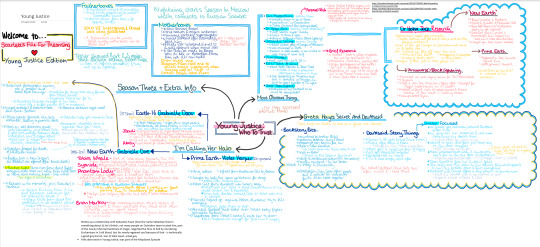
#young justice#halo#young justice theory#young justice s3#yj s3#young justice outsiders#violet harper#greta hayes#secret#darkseid#apokolips#dc universe#dc comics#wally west#black lightning#batfamily#nightwing#artemis#new 52#dc rebirth#flash#yj theory
47 notes
·
View notes
Text
Popular Front End Development Tools You Should Know
If you are just getting started with JavaScript, the number of tools and technologies you'll hear about may be overwhelming. And you might have a hard time deciding which tools you actually need.
Or maybe you're familiar with the tools, but you haven't given much thought to what problems they solve and how miserable your life would be without their help.
I believe it is important for Software Engineers and Developers to understand the purpose of the tools we use every day.
That's why, in this article, I look at NPM, Babel, Webpack, ESLint, and CircleCI and I try to clarify the problems they solve and how they solve them.
NPM

NPM is the default package manager for JavaScript development. It helps you find and install packages (programs) that you can use in your programs.
You can add npm to a project simply by using the "npm init" command. When you run this command it creates a "package.json" file in the current directory. This is the file where your dependencies are listed, and npm views it as the ID card of the project.
You can add a dependency with the "npm install (package_name)" command.
When you run this command, npm goes to the remote registry and checks if there is a package identified by this package name. If it finds it, a new dependency entry is added to your package.json and the package, with it's internal dependencies, is downloaded from the registry.
You can find downloaded packages or dependencies under the "node_modules" folder. Just keep in mind that it usually gets pretty big – so make sure to add it to .gitignore.
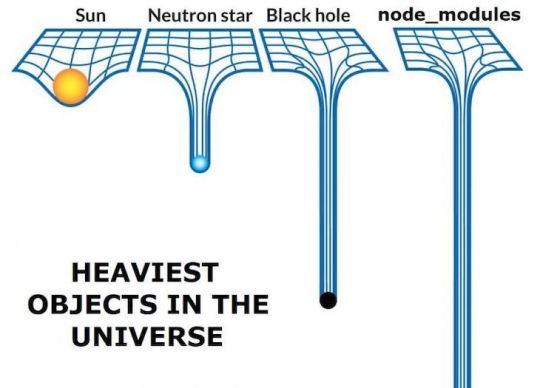
NPM does not only ease the process of finding and downloading packages but also makes it easier to work collaboratively on a project.
Without NPM, it would be hard to manage external dependencies. You would need to download the correct versions of every dependency by hand when you join an existing project. And that would be a real hassle.
With the help of npm, you can just run "npm install" and it will install all external dependencies for you. Then you can just run it again anytime someone on your team adds a new one.
Babel

Babel is a JavaScript compiler or transpiler which translates the ECMAScript 2015+ code into code that can be understood by older JavaScript engines.
Babel is the most popular Javascript compiler, and frameworks like Vue and React use it by default. That said, concepts we will talk about here are not only related to Babel and will apply to any JavaScript compiler.
Why do you need a compiler?
"Why do we need a compiler, isn't JavaScript an interpreted language?" you may ask if you are familiar with the concepts of compiled and interpreted languages.
It's true that we usually call something a "compiler" if it translates our human-readable code to an executable binary that can be understood by the CPU. But that is not the case here.
The term transpiler may be more appropriate since it is a subset of a compiler: Transpilers are compilers that translate the code from a programming language to another language (in this example, from modern JS to an older version).
JavaScript is the language of browsers. But there is a problem with browsers: Cross compatibility. JavaScript tools and the language itself are evolving rapidly and many browsers fail to match that pace. This results in compatibility issues.
You probably want to write code in the most recent versions of JavaScript so you can use its new features. But if the browser that your code is running has not implemented some of the new features in its JavaScript engine, the code will not execute properly on that browser.
This is a complex problem because every browser implements the features at a different speed. And even if they do implement those new features, there will always be people who use an older version of their browser.
So what if you want to be able to use the recent features but also want your users to view those pages without any problems?
Before Babel, we used polyfills to run older versions of certain code if the browser did not support the modern features. And when you use Babel, it uses polyfills behind the scenes and does not require you to do anything.
How do transpilers/compilers work?
Babel works similar to other compilers. It has parsing, transformation, and code generation stages.
We won't go in-depth here into how it works, since compilers are complicated things. But to understand the basics of how compilers work, you can check out the the-super-tiny-compiler project. It is also mentioned in Babel's official documentation as being helpful in understanding how Babel works.
We can usually get away with knowing about Babel plugins and presets. Plugins are the snippets that Babel uses behind the scenes to compile your code to older versions of JavaScript. You can think of each modern feature as a plugin. You can go to this link to check out the full list of plugins.
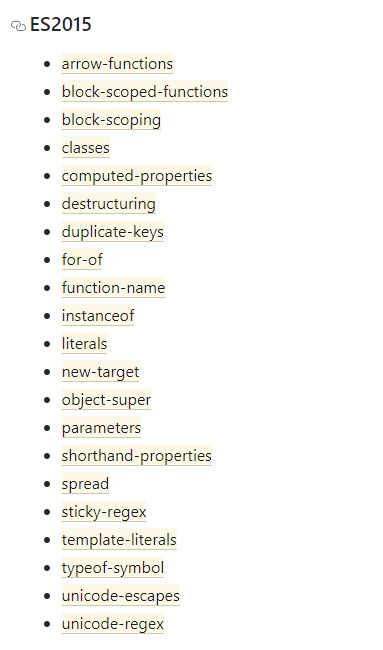
List of plugins for ES5
Presets are collections of plugins. If you want to use Babel for a React project you can use the pre-made @babel/preset-react which contains the necessary plugins.

React Preset Plugins
You can add plugins by editing the Babel config file.
Do you need Babel for your React App?
For React, you need a compiler because React code generally uses JSX and JSX needs to be compiled. Also the library is built on the concept of using ES6 syntax.
Luckily, when you create a project with create-react-app, it comes with Babel already configured and you usually do not need to modify the config.
Examples of a compiler in action
Babel's website has an online compiler and it is really helpful to understand how it works. Just plug in some code and analyze the output.


Webpack
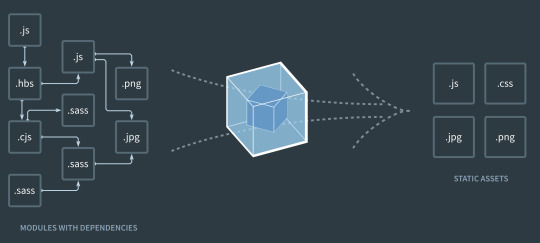
Webpack is a static module bundler. When you create a new project, most JavaScript frameworks/libraries use it out of the box nowadays.
If the phrase "static module bundler" sounds confusing, keep reading because I have some great examples to help you understand.
Why do you need a bundler?
In web apps you're going to have a lot of files. This is especially the case for Single Page Applications (React, Vue, Angular), with each having their own dependencies.
What I mean by a dependency is an import statement – if file A needs to import file B to run properly, then we say A depends on B.
In small projects, you can handle the module dependencies with <script> tags. But when the project gets larger, the dependencies rapidly become hard to manage.
Maybe, more importantly, dividing the code into multiple files makes your website load more slowly. This is because the browser needs to send more requests compared to one large file, and your website starts to consume a ton of bandwidth, because of HTTP headers.
We, as developers want our code to be modular. We divide it into multiple files because we do not want to work with one file with thousands of lines. Still, we also want our websites to be performant, to use less bandwidth, and to load fast.
So now, we'll see how Webpack solves this issue.
How Webpack works
When we were talking about Babel, we mentioned that JavaScript code needs to be transpiled before the deployment.
But compiling with Babel is not the only operation you need before deploying your project.
You usually need to uglify it, transpile it, compile the SASS or SCSS to CSS if you are using any preprocessors, compile the TypeScript if you are using it...and as you can see, this list can get long easily.
You do not want to deal with all those commands and operations before every deployment. It would be great if there was a tool that did all that for you in the correct order and correct way.
The good news – there is: Webpack.
Webpack also provides features like a local server with hot reload (they call it hot module replacement) to make your development experience better.
So what's hot reloading? It means that whenever you save your code, it gets compiled and deployed to the local HTTP server running on your machine. And whenever a file changes, it sends a message to your browser so you do not even need to refresh the page.
If you have ever used "npm run serve", "npm start" or "npm run dev", those commands also start Webpack's dev server behind the scenes.
Webpack starts from the entry point of your project (index) and generates the Abstract Syntax Tree of the file. You can think of it as parsing the code. This operation is also done in compilers, which then look for import statements recursively to generate a graph of dependencies.
It then converts the files into IIFEs to modularize them (remember, putting code inside a function restricts its scope). By doing this, they modularize the files and make sure the variables and functions are not accessible to other files.
Without this operation, it would be like copying and pasting the code of the imported file and that file would have the same scope.
Webpack does many other advanced things behind the scenes, but this is enough to understand the basics.
Bonus – ESLint

Code quality is important and helps keep your projects maintainable and easily extendable. While most of us developers recognize the significance of clean coding, we sometimes tend to ignore the long term consequences under the pressure of deadlines.
Many companies decide on coding standards and encourage developers to obey those standards. But how can you make sure that your code meets the standards?
Well, you can use a tool like ESLint to enforce rules in the code. For example, you can create a rule to enforce or disallow the usage of semicolons in your JavaScript code. If you break a rule, ESLint shows an error and the code does not even get compiled – so it is not possible to ignore that unless you disable the rule.
Linters can be used to enforce standards by writing custom rules. But you can also use the pre-made ESLint configs established by big tech companies to help devs get into the habit of writing clean code.
You can take a look at Google's ESLint config here – it is the one I prefer.
ESLint helps you get used to best practices, but that's not its only benefit. ESLint also warns you about possible bugs/errors in your code so you can avoid common mistakes.
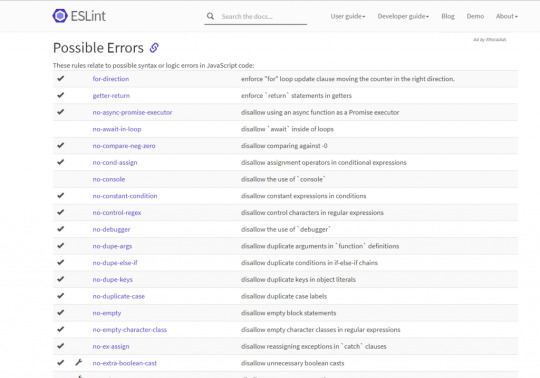
Bonus – CI/CD (CircleCI)

Continuous Integration/Development has gained a lot of popularity in recent years as many companies have adopted Agile principles.
Tools like Jenkins and CircleCI allow you to automate the deployment and testing of your software so you can deploy more often and reliably without going through difficult and error-prone build processes by yourselves.
I mention CircleCI as the product here because it is free and used frequently in JavaScript projects. It's also quite easy to use.
Let's go over an example: Say you have a deployment/QA server and your Git repository. You want to deploy your changes to your deployment/QA server, so here is an example process:
Push the changes to Git
Connect to the server
Create a Docker container and run it
Pull the changes to the server, download all the dependencies (npm install)
Run the tests to make sure nothing is broken
Use a tool like ESLint/Sonar to ensure code quality
Merge the code if everything is fine
With the help of CircleCI, you can automatically do all these operations. You can set it up and configure to do all of the above operations whenever you push a change to Git. It will reject the push if anything goes wrong, for example a failing test.
I will not get into the details of how to configure CircleCI because this article is more about the "Why?" of each tool. But if you are interested in learning more and seeing it in action, you can check out this tutorial series.
Conclusion
The world of JavaScript is evolving rapidly and new tools are gaining popularity every year.
It's easy to react to this change by just learning how to use the tool – we are often too busy to take our time and think about the reason why that tool became popular or what problem it solves.
In this article, I picked the tools I think are most popular and shared my thoughts on their significance. I also wanted to make you think about the problems they solve rather than just the details of how to use them.
If you liked the article you can check out and subscribe to my blog where I try to write frequently. Also, let me know what you think by commenting so we can brainstorm or you can tell me what other tools you love to use :)
0 notes
Text
Mabbuwl - The Great Flood
Many of us, if we are to be honest with ourselves, first came to God for selfish reasons. Some of us might still have mostly selfish reasons for coming to church and worshiping God. In a place where we come to God because we are struggling, and we want God to make it all better. Many come to God wanting Him to remove our obstacles, our struggles. We come to God, perhaps, seeking worldly prosperity.
It makes sense right? Think of Job, Abraham, Isaac, Jacob, Joseph, Moses, David, Solomon, Daniel, Esther so many powerful and wealthy people are found throughout Scriptures. There are enough stories of success in the Bible for a prosperity gospel to be preached.
The problem is what happens when my personal experience ends up being different from what I expected it to be. What happens when I come to God expecting Him to take away all my trials, and I end up facing more trials than before? What happens when I am expecting an easy life and I don't get it?
What happens to my faith, when I obey God, and things seem only to become more challenging?
A more careful reading of the stories of all the heroes mentioned above teaches us that all of them faced extraordinary challenges. There are blessings that come with following God, no questions about it. But do not fool yourself into thinking there will be no challenges.
Let's see what lessons we can learn from taking a closer look at the life of a man God described as being just and perfect, a man who walked with God.
Noah.
Mabbuwl
(Mabbuwl is the transliteration of the Hebrew word for flood)
"When mankind were overwhelmed with the deluge, none were preserved but a man named Coxcox … and a woman called Xochiquetzal, who saved themselves in a little bark, and having afterwards got to land upon a mountain called by them Colhuacan, had there a great many children; … these children were all born dumb, until a dove from a lofty tree imparted to them languages, but differing so much that they could not understand one another." -- (Frazer, J.G., Folklore in the Old Testament: Studies in Comparative Religion, Legend and Law (Abridged Edition), Avenel Books, New York, NY, USA, p. 107, 1988. mentioned on http://creation.com/many-flood-legends)
Sounds familiar? Reminds you of the story of Noah's Ark and the Tower of Babel?
This story comes from the Aztecs of Mexico—one of many recorded flood stories, from geographically remote and widely divergent cultures.
Did you know there are some 270 flood stories recorded around the world according to The International Standard Bible Encyclopedia? (Vos. H. F. 1982. Flood (Genesis). In G. W. Bromiley (ed.), The International Standard Bible Encyclopedia, Vol. 2, pp. 319-321. Wm. B. Eerdmans Publishing Co., Grand Rapids, Michigan. mentioned on http://www.grisda.org/origins/17051.htm)
The existence of so many versions of the flood story is a significance challenge for those who want to deny a global flood ever took place, especially when so many of the stories have specific commonalities. There is much debate over the historicity of the biblical flood account, and that is not the focal point of this post. However, I would like to mention that a worldwide flood as described in the Bible helps explain many questions regarding the creation vs evolution debate.
I mention these points in passing for those who are interested to feel free to pursue them. On this post, I wish to focus on the biblical text and what God wants to teach us through this narrative. There are plenty of sites debating the science of the flood, I wish to discuss its theological implications, especially since I am not a scientist.
Continuing our study of the narrative of the Great Flood (Mabbuwl) we turn to Genesis 7.
Repetition?
Before we get into the text I would just like to briefly explain a literary device known as Hebrew parallelism, in which a story is told in two complementary versions that proceed from the general to the specific. There are several examples of this found in the Bible such as the two creation accounts found in Genesis 1:1-2:4a and Genesis 2:4b-25 and Daniel's visions found in Daniel 2 and Daniel 7.
Here in Genesis 7 we have the broad narrative of Noah entering into the ark found in Genesis 7:6-9. Followed by a more detailed second narrative in verses 10-16a. Notice how each narrative ends the same way, saying "as God had commanded" (Genesis 7:9, 16).
I mention this ahead of time as to avoid confusion when we read the story.
Genesis 7
Right away on verse 1 God is giving Noah a command.
Come into the ark, ...
The last time God gave Noah a command was when God told him to build the ark, (Genesis 6:14). Now God is commanding Noah to come into the ark, keeping His covenant with Noah (Genesis 6:18). We notice also that Noah is righteous before God, implying his righteousness is not his own but rather given according to God. (Doukhan, Jacques. Genesis. Nampa, ID: Pacific Press Publishing Association, 2016. Print. p146)
Clean and Unclean
Verse two is very interesting in that it differentiates between clean and unclean animals. Many will recognize this distinction from Leviticus 11:1-47 and Deuteronomy 14:3-21. This must make the reader wonder why God is differentiating between the clean and unclean animals before before the building of the Tabernacle, before the giving of the 10 commandments, before the Exodus, before Moses, before Abraham, etc. Why would God differentiate between clean and unclean animals if there were no Jews, unless this differentiation was not meant just for the Jews.
Notice also that God does not have to explain to Noah how to differentiate between the clean and unclean animals. As the text reads, we get the idea that Noah is already familiar with the distinction. We see this more clearly in Genesis 8:20 where Noah offers sacrifices to God out of the clean animals. Apparently some of the instructions God gave Moses for the people of Israel were not limited to them, nor were they new instructions.
According to Leviticus 11, the differentiation between clean and unclean animals was not just connected to the tabernacle and sacrificial system but also to diet. Leviticus 11 says God spoke to Moses and Aaron and told them which animals they were allowed to eat. It is consistent, and it makes sense, for there to be a greater need for clean animals than unclean in the ark if the clean animals would be used for sacrifice as well as food. The unclean animals, are also important but are not meant for human consumption nor for sacrifices.
I raise this point here, but will pursue it no further in this post, if you would like to explore this topic further feel free to contact me. (I might pursue this topic further in a future post.)
Global Destruction of Life
Verse 4 reminds the reader that God is going to destroy all life from the face of the earth which He had created. Here I would like to make a quick mention of the multiple flood accounts found in diverse cultures around the world. Though many of them have several similarities with the biblical account of the flood, the Bible is unique in its account, and part of what makes the Bible unique is the way it portrays God. God is intentional and deliberate. God has a moral code, God saves Noah, his family, and a representation of the animals. God is intentional, God is moral, God guides and preserves Noah and the animals, and God has a clear purpose and reason for doing so. The flood is not an accident, neither is it a fit of rage, but rather an act of judgment from a moral and almighty God.
God is not careless, God is searching for someone to save and is careful not to destroy the righteous along with the wicked (Genesis 18:23). Noah is spared because of his character. Noah has a loving and personal relationship with God which involves obedience to God's commands.
Noah's Age
Why mention that Noah was 600 years old? (Genesis 7:6, 11) I believe this establishes the historical value of this account. Noah's life bridges the antediluvian world and the our postdiluvian world, the world of Abraham, Isaac and Jacob and all the other biblical characters. Jesus (Matthew 24:37-39) as well as Peter (2 Peter 3:5-7) both refer to the flood narrative and use it as a warning for our generation regarding God's final judgment. In other words, the Bible treats the flood account as being a real historical event and not a metaphorical illustration.
Reflections
Moving away from the detailed analysis of the biblical text for a moment. Imagine what it must have been like for Noah to go through this experience.
First, imagine living in a neighborhood where every intent of the thoughts of the hearts of your neighbors is only evil continually. (Genesis 6:5)
Now imagine that its not just that you're in a bad neighborhood, but rather it is the whole world. you can't just move to a nicer neighborhood, it is not a temporary problem that you can solve by relocating. There are no exceptions. You have no good friends. You are the only just person living on the planet and you can't move out. I know you might feel like you can't trust anyone nowadays, but imagine that being the case globally. (Genesis 6:12)
Things get so bad God is going to destroy everyone. Only you and your family will be spared. It is very likely that you had been praying for God to do something for a while. You just never expected for God to do this. God will destroy all life on the planet. Except you and your family, and a sample from all the animals on the planet, and seven pairs of the clean animals. (Genesis 6:17-20, 7:2-3, 14-16)
And by the way, God will not save you in a magical bubble, He will not simply take you to heaven for a few days while He cleans things up here on earth.
No.
God calls you to build a massive boat. He gives you all the directions and details concerning the project (6:14-16). Imagine spending the following 120 (6:3) years building and preaching (2 Peter:2:5) to people about the coming flood. By the way, Noah will also have to gather food himself, for the animals, and his family (Genesis 6:21).
God could have easily taken care of all this. Noah did find grace in the eyes of the LORD (6:8), yet the LORD did not take away the challenges. For many years, things seem to just become even more challenging.
It is too easy for us to read the story of the flood and not take a moment to consider what it must have been like for Noah. Can you imagine the taunts he must have suffered? Can you imagine the work of building a massive boat. The challenges of believing and acting on it without having any tangible proof for completely changing your life and taking on a major project that will cost you a great amount of time and resources?
Imagine
Imagine changing your life completely because God revealed to you that the whole world will be destroyed. Imagine living differently because Jesus is coming again. Imagine going through some discomfort to obey God's will according to what He has revealed to you.
Imagine God speaking to you and letting you know that judgment is coming. This time not by water but by fire. Imagine believing the words found in texts like Malachi 4:1
“For behold, the day is coming, burning like an oven, when all the arrogant and all evildoers will be stubble. The day that is coming shall set them ablaze, says the LORD of hosts, so that it will leave them neither root nor branch. -Malachi 4:1
Discomfort
I imagine the ark was not very comfortable. I can imagine the noise and the smell and the mess all those animals made. Sometimes the church can feel like the ark. You may feel like you're dealing with wild animals at times. Maybe your toes get stepped on, perhaps your experience is not always a pleasant one.
You think about leaving.
This is not what you signed up for when you decided to follow Jesus. You wanted things to get easier not harder. You wanted relief from your trials, not brand new ones. And many will abandon God because they consider it too troublesome to follow Him. Many will walk away from a loving relationship with Jesus because having Jesus as their Lord can be "uncomfortable" at times.
Practical Applications
It is easy for me to get so excited about the details of the text and all the fascinating theological points and questions to be pondered, and end up missing what the human experience might have been like, and how that relates to my current experience.
How do you react when God calls you to build a boat, and you have never even built a raft? Maybe God is not calling you to build a literal boat, but He is calling you out of your comfort zone, and strictly for the benefit of others.
How do you react when your obedience and faithfulness get rewarded with more work and responsibilities?
How do you feel when God reveals to you that your obedience allows others close to you to experience God's mercy? That your relationship with God contributes to the salvation of those closest to you?
Noah was not a young man when God called him. He obediently labored for years, apparently without hearing anything from God. The whole process took time! There was a lot of working, and silence, and challenges, and waiting, and working.
Faith
Genesis 7:4, 7, 10 informs us that Noah and his family and all the animals waited in the ark for seven days before the flood came.
Seven days.
Waiting.
Wondering.
Waiting.
Thinking.
"Did we hear right?"
"Did we interpret God's message accurately?"
"Did we do everything correctly?"
"Did we miss something?"
Waiting.
Those must have been the longest seven days of Noah's life. Seven days. Waiting. Wondering. When you're busy its not so bad. But when it seems like nothing is happening, what do you do? What do you do when you follow what God has revealed to you of His will, to the best of your abilities, and nothing happens?
The Text
Looking back at the biblical text you may wonder how to interpret Genesis 7:13 in light of verses 4, 7 and 10. Remember what I mentioned about Hebrew parallelism? The story repeats, the second time with more details. Genesis 7:13 explains in greater detail that Noah and his family and all the animals entered the ark on the same day. The day the rain began they had already entered the ark. I wrote the "already" to identify that the Hebrew verb "enter" used in verse 13 is in the perfect tense, describing an action that has been completed. As apposed tot he verb "enter" used in verse 7 is in the imperfect tense, indicating the action was taking place.
Shut Door
Notice that verse 16 points out that the LORD shut Noah in.
God shut the door to the ark, not Noah.
After that point, no one could enter the ark. The door was shut before the rain began. Whoever entered the ark, entered by faith. By the time the rain began to fall, it was already too late to enter into the ark.
The idea of the door to salvation being shut is also found in the parable of the 10 virgins found in Matthew 25:10. the same principle is described Revelation 22:11 with the words
He that is unjust, let him be unjust still: and he which is filthy, let him be filthy still: and he that is righteous, let him be righteous still: and he that is holy, let him be holy still. (Revelation 22:11 King James Bible)
By now you must have begun to realize that the judgment stories in Genesis help us understand how God goes about this process. You probably already noticed that properly understanding judgment in Genesis helps you better interpret Matthew 24 and especially 25. Perhaps even more clear is the realization that this topic is expounded on throughout the book of Revelation. Same God, same modus oprandi, same theology.
Redundancy?
Take a look at Genesis 7:17-24 and see what you think?
I am reminded of my high school English teacher who would write "RR" on parts of my essay. "RR" stood for repetitive and redundant.
As you read verses 17-20 you get the idea of the waters rising. With each verse there is more and more water, covering more and more things. The text leaves no room for anyone to doubt the universality of the flood. It was a global event, everything on earth was submerged.
In case you still have any doubt verse 21 begins another repetitious and redundant portion of the text. This time emphasizing who or what died. Everything, everyone, who was on the face of the earth died.
There was no salvation available outside of the ark. No other boats made it. No one outside the ark made it. God had provided a single means of salvation. (John 14:6) (side note: Some might want to argue that it would be unlike God to provide the whole world with a single means of salvation. To me it seems consistent with biblical text.)
Repetition is how the biblical writers highlighted something important. There is a lot of repetition in these verses in order to clearly convey, beyond a shadow of doubt, that God brought about thorough destruction of life. God used a global flood and spared only those who were in the ark.
Takeaway
We have looked closely at the text. We have imagined what it must have felt like to be Noah. We looked at some practical and theological implications, and now what?
What do I take away from all this?
What did I learn about
God
God is the judge over all the earth.
God clearly communicates to his servant/friend Noah what to do at each step of the process (build and ark, get in the ark, etc.)
God cares about the animals too.
God designated some animals for human consumption and others not.
God wants to partner with humanity.
Humanity
We don't always see the big picture of what God is doing.
We need to act by faith (believe God before we see any evidence).
God can work through us to save others.
Application
Life has many challenges.
Following God does not remove all challenges from life.
Following God introduces new challenges to life.
We can face any challenge (even a global flood), when we love God and follow what he calls us to do ("Come into the ark" Gen. 7:1).
In light of this story, life is not about avoiding challenges. Being a believer or follower of God is not about eliminating challenges. But rather about facing the right challenges according to God's revealed will. Life is about faithfulness to God and what He has called you to do.
Right now the door is open. We don't know how long it will be open. God will not force anyone to get into the ark, but He does call.
Today, if you hear his voice, do not harden your hearts... (Heb. 3:15)
Life is hard. Following God is challenging. If I have to face challenges anyway, I would rather face the challenges God call me to face, because I know that He is faithful. (1 Thess. 5:24)
0 notes